Turtle Tragedy: Why Do Turtles Die Suddenly?
In some cultures, the turtle is a symbol of long life and calmness. People believe these reptiles can survive through hardship and threats. They worship it for longevity. However, turtles can also face many threats that can lead to their unforeseen death.
But what are the reasons? Why do turtles die suddenly? Turtles may pass away unexpectedly due to a variety of causes, and it often relies on improper diet, poor habitat, old age, and untreated medical conditions. Besides them, infections, parasites, respiratory problems, environmental stressors, starvation, trauma, stress from captivity, toxic exposure, and environmental variables like temperature or pollution are some of the most typical causes of unexpected turtle deaths.
It is not always easy to tell the reason. But with some knowledge and help, you may identify the cause. In some cases, if you notice the problem early, you may prevent this unwanted departure. This article can help you with these.
Interested in similar topics on turtle:
What Are the Reasons for the Sudden Death of a Turtle?
Without performing an animal autopsy, known as a necropsy, it might be difficult to pinpoint the precise cause of a turtle’s abrupt death. But we have outlined several typical causes of sudden turtle death, such as:
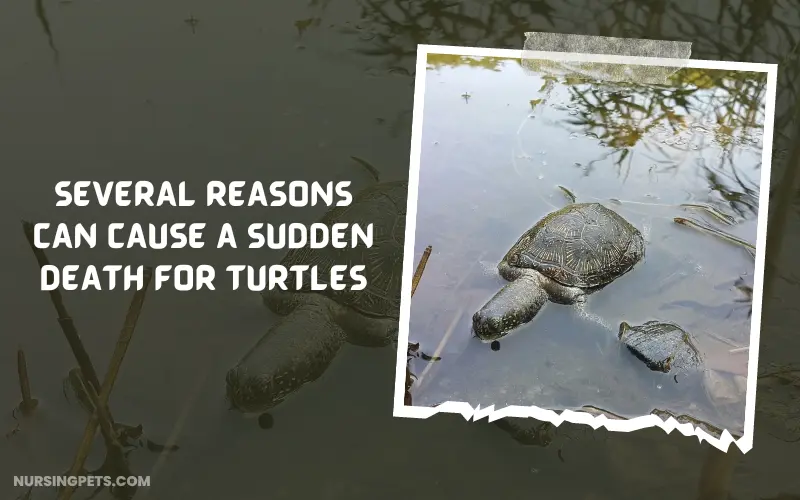
1. Poor Water Quality
Turtle health and welfare are greatly influenced by water quality. Poor water can cause diseases or stress that can affect the turtle’s health and survival. Also, it can lead to low oxygen levels in the water, which can suffocate turtles and other aquatic organisms.
The water in a turtle’s environment provides them with a source of drinking water and a location to swim, eat, and eliminate waste.
If the water quality is poor due to high levels of waste and uneaten food in the habitat, harmful bacteria and fungi can grow. These can cause skin and shell infections in turtles.
2. Drowning
Some turtles are semi-aquatic and need to breathe air. If they cannot reach the surface, they may drown. Unlike aquatic turtles that can extract oxygen from water through specialized adaptations, semi-aquatic turtles need to surface periodically to breathe air.
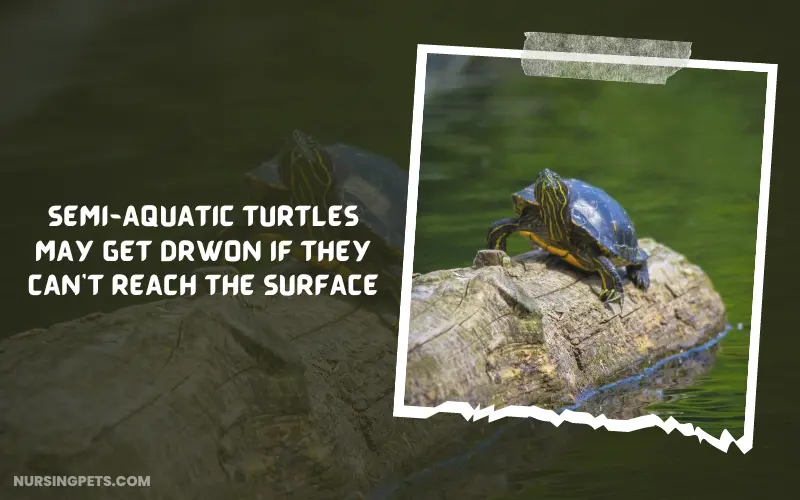
So, if they become trapped underwater or are unable to access the surface, they can suffocate and drown.
3. Temperature Fluctuation
Turtles may die suddenly from drastic temperature changes. As ectothermic creatures, their well-being relies on the environment for temperature regulation.
Rapid and extreme temperature changes can induce stress, disrupt metabolism, impact respiration, challenge thermoregulation, and disturb hibernation or brumation patterns, potentially leading to health issues or even death.
The turtles may grow sluggish and stop eating if the environment temperature is too low. In severe circumstances, they would experience hypothermia, which might result in organ failure and death.
On the other hand, dehydration, heat stroke, and other medical conditions that might result in abrupt death can be brought on by an excessively hot environment.
4. Lack of Proper Lighting
For their metabolic processes to function properly, turtles need a certain ratio of light to darkness. They need UVB light to produce Vitamin D3, which is vital for their shell and bone growth. Without UVB light, turtles can develop metabolic bone disease, which can be fatal.
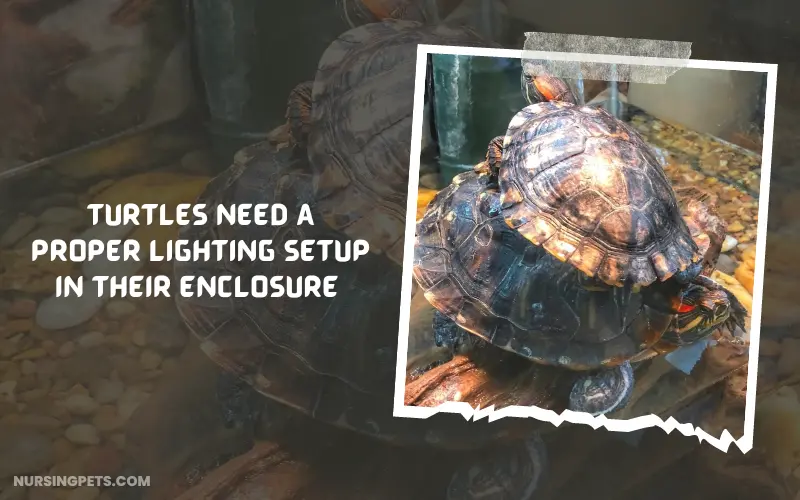
Turtles also need a day-night cycle to regulate their behavior and metabolism. Artificial lighting can disrupt this cycle and cause disorientation or stress.
In some cases, improper lighting can cause shell deformities, disrupt natural behaviors, weaken the immune system, hinder shell health and growth, impair vision, and reduce overall vitality.
5. Overfeeding or Underfeeding
Overfeeding can cause obesity and various health problems in turtles, such as organ damage or shell deformity. It can also lead to water pollution due to excess waste.
Alternatively, underfeeding can cause malnutrition and weaken the turtle’s immune system, stunting development and making it more susceptible to infections or diseases. Therefore, turtles need a balanced and varied diet that meets their nutritional needs.
6. Bacterial Infections
Turtles often get bacterial infections, which may quickly result in death if left untreated. A number of things, including tainted food, water, and surroundings, may cause turtles to contract bacteria.
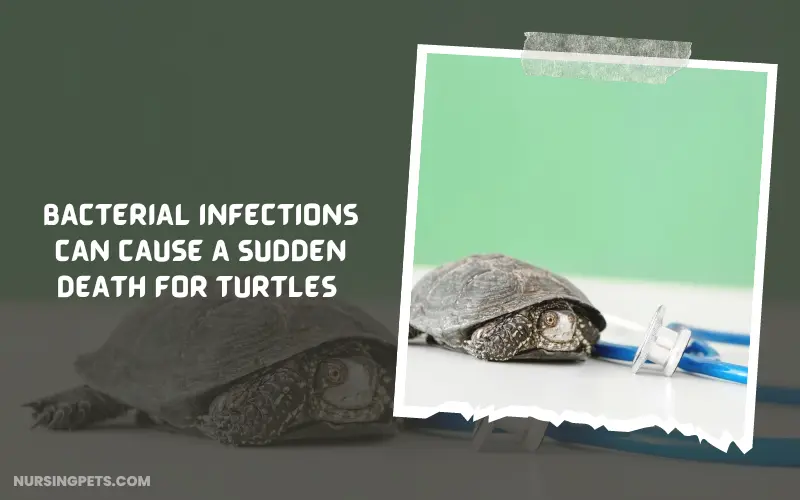
Lethargy, appetite loss, swollen or diseased regions, and respiratory issues are a few of the usual symptoms of bacterial infections in turtles. The infection may sometimes show up on the skin as sores or lesions.
7. Parasites
Parasites are organisms that live in or on another organism and feed on its nutrients. Turtles can be infected by various types of parasites, such as nematodes, tapeworms, flukes, and mites. Parasites can cause damage to the turtle’s organs, blood vessels, skin, and immune system.
They can also transmit other infections or diseases. Some symptoms of a parasitic infection are dehydration, diarrhea, vomiting, weight loss, anemia, and inflammation. The parasite may sometimes be seen in the feces or in the area of the cloaca.
8. Respiratory Illness
Respiratory illness is a condition that affects the turtle’s lungs and airways. Bacteria, viruses, or poor environmental conditions can cause it. This illness can make it hard for the turtle to breathe, eat, swim, or dive.
Some signs of respiratory illness are difficulty breathing, mucus or bubbles around the mouth, eyes, or nostrils, coughing or wheezing, decreased energy, lack of appetite, and swimming lopsided. It needs to be treated by a vet with medications and supportive care.
9. Trauma
Trauma is a physical injury that can damage the turtle’s body. It can be caused by car accidents, predator attacks, human interference, or environmental hazards. Trauma can result in fractures, bleeding, infection, organ damage, or neurological deficits.

From simple bruising and scratches to more severe wounds like fractured bones or internal organ damage, trauma may affect everyone. This needs to be treated by a vet with surgery, antibiotics, pain relief, and rehabilitation.
The capacity to move or difficulty in swimming, bleeding, swelling, and behavioral changes, such as weariness or an inability to eat, are some prominent indicators of trauma in turtles.
10. Environmental Stressors and Inadequate Care
Imagine how stress can weaken our immune systems. Similarly, turtles experience stress from factors like abrupt changes in the environment, improper lighting, and insufficient diet.
Moreover, inadequate care, such as overcrowded enclosures or unsanitary conditions, can exacerbate these stressors, making them prone to sudden health declines.
11. Internal Health Problems
Turtles, like any other animals, can suffer from various internal health issues such as organ failure, tumors, or other problems that might not be immediately apparent. These can be deadly for turtles and can cause sudden death for your reptile friend.
12. Age
Depending on the species, some turtles might have shorter lifespans or be more susceptible to age-related health issues. Turtles can live for a long time, but they are not immortal. As they age, they may become more vulnerable to illness and injury.
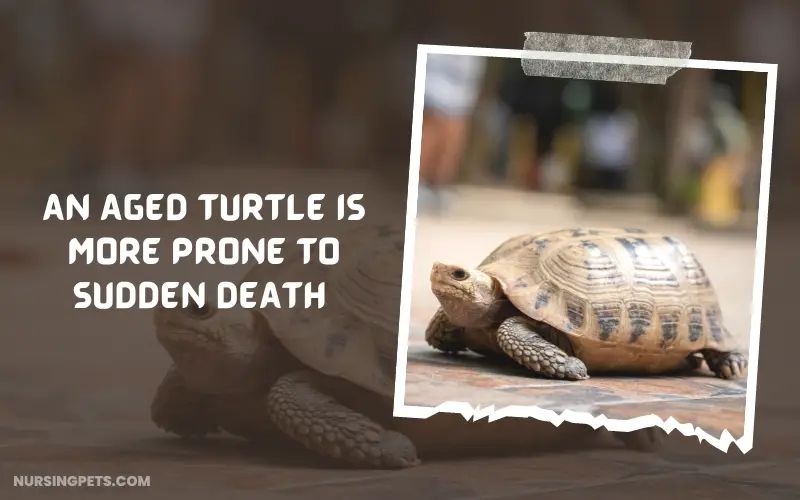
If your turtle is too old or has age-related health issues, it can die suddenly without showing any noticeable changes.
13. Toxic Substances
Exposure to toxic chemicals or substances, either in their habitat or through the food they consume, can be fatal to turtles.
This can occur through ingestion, inhalation, absorption, or contact. Toxic exposure can cause poisoning, internal injuries, inflammation, infection, or death.
Preventing pollution and monitoring water and soil quality are crucial to safeguard turtles from these dangers.
14. Natural Predators and Pollution
Just as humans encounter threats in our environment, turtles face theirs too. Natural predators in the wild can prey on them, while pollution poses a risk in both wild and captive environments.
Captive turtles can suddenly face predators, too. Some of the common predators for turtles are- raccoons, snakes (especially for smaller turtles), birds, etc.
15. Accidents
Turtles can sometimes accidentally injure themselves within their enclosure, or they might get caught in something that leads to injury or death.

However, as mentioned, without a proper examination by an expert, it is hard to say what caused your turtle’s sudden death. But the mentioned points are the usual reasons you may find.
How Sea Turtles Can Face Sudden Death?
Sea turtles can face sudden death due to various factors, such as human activities, natural disasters, or diseases. Some examples of human activities that can kill sea turtles are fishing, poaching, pollution, and shipping.
Storms, earthquakes, volcanoes, or tsunamis are some natural disasters that can harm sea turtles. Fibropapillomatosis, herpesvirus, or salmonella are some diseases that can kill sea turtles. They can also be victims of predation in the ocean or beach areas.
How Do Turtles Die Naturally?
Turtles usually have a long lifespan, depending on the species. However, they can die naturally due to old age, disease, or predation. They can also suffer from various diseases, such as parasites, infections, or tumors.
Moreover, turtles can fall prey to other animals, such as birds, fish, crocodiles, or humans. They are vulnerable to predation, especially when they are young, nesting, or migrating.
In addition, certain turtle species may have shorter life spans than others and may be more vulnerable to certain diseases, including respiratory infections or shell disease, which may increase natural mortality.
What Is the Lifespan of a Turtle?
The lifespan of a turtle depends on the species, the diet, and the environment of the turtle. A typical pet turtle can live between 10 and 80 years or so, while larger species can easily live over 100 years.

Sea turtles typically live between 30 and 50 years, but some can live up to 150 years or more. The oldest living turtle and land animal is said to be a Seychelles giant tortoise named Jonathan, who turned 187 in 2019.
Do Baby Turtles Die Easily?
Baby turtles, just like numerous young creatures, are susceptible and may experience increased death rates compared to mature ones.
In their natural habitat, a lot of baby turtles may not make it to maturity because of predators, the destruction of their living space, or other conditions in their surroundings.
When kept in captivity, young turtles could be exposed to potential danger without appropriate attention. For instance, if they are placed in excessively deep or cold water, they might experience stress and become more prone to sickness.
Moreover, wrong diet or feeding habits can cause health issues and possibly even demise in young turtles. According to some states, baby turtles have a very low survival rate, with only about one in a thousand reaching adulthood.
What Are the Signs of a Dying Turtle?
A turtle that is dying may not show any visible signs. And without an expert or veterinarian examination, it might be difficult for you to identify. But we can give you some general information that may give you some indication. Let’s take a look at them.
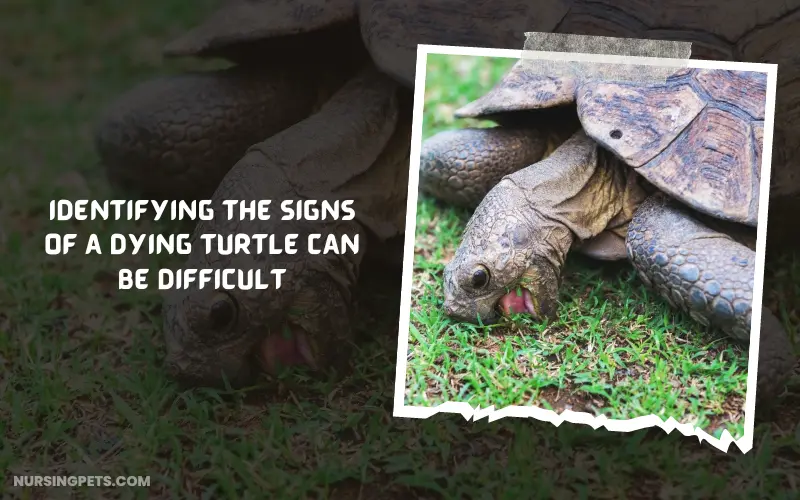
Some signs of a dying turtle are:
- Lack of appetite or refusal to eat
- Lethargy or reduced activity and movement
- Excessive basking or staying out of the water for long periods
- Breathing problems such as gasping, wheezing, or coughing
- Bubbling or discharge from the mouth, nose, ears, or eyes
- Difficulty swimming or floating sideways or upside down
- Discoloration or darkening of the shell and skin
- Skin problems such as peeling, bleeding, or ulceration
- Shell infections or deformation such as cracks, holes, or softness
- Unusual Droppings- changes in the color, consistency, or frequency
- Visible Injuries, any wounds, lesions, or injuries
- Unresponsiveness: Dying turtles may not react to external stimuli or may respond very weakly
These signs can indicate that your turtle is dying or suffering from a serious illness. You should take your turtle to a veterinarian as soon as possible for diagnosis and treatment.
How to Tell If Your Turtle is Hibernating or Dead?
It can be hard to tell if a turtle is hibernating or dead, but there are some clues you can look for. A hibernating turtle will still have some muscle control and be able to tuck its head and legs inside its shell when picked up. A dead turtle will be limp and unresponsive.

Moreover, a hibernated one feels slightly warmer than its surroundings, while a dead one will feel as cold as its surroundings. Also, a dead turtle will have a rotten and shriveled shell and skin, deep sunken eyes, a bad odor, and may be covered in flies or maggots.
However, if you are not sure, you can gently touch its eye or nostril to see whether it reacts. If it does not, it may be dead.
Do Turtles Die with Their Eyes Open?
Turtles can die with their eyes open or closed, depending on how their muscles relax at the time of death. It is not a sign of pain or fear but rather a matter of chance.
Most turtles die with their eyes closed, as death is usually peaceful for them. However, some may have their eyes open or sunken when they die. You should not rely on the eyes alone to determine if a turtle is dead or alive.
How to Prevent Sudden Turtle Death?
The avoidance of the abrupt demise of turtles necessitates a blend of sound animal care procedures and vigilant attention. Here are some suggestions to maintain the well-being of turtles and minimize the possibility of unexpected demise:

Remember that different species of turtles have varying care requirements, so research the specific needs of your turtle’s species. If you’re not sure about any aspect of turtle care, consult this with an expert for a proper guideline.
What to Do If Your Turtle Dies Suddenly?
Losing a pet can be distressing. And if you are facing a situation like this, our thoughts are with you. However, if your turtle is dead, there are some things you should do. You may follow these:
- Confirm that the turtle is dead and not just injured or in shock. Look for signs such as no movement, no response to touch, and cloudy eyes. You can also try to rewarm the turtle in a tub with room temperature water for 15-30 minutes and check for signs of life.
- Remove the turtle from its enclosure and clean and disinfect it to prevent any disease.
- Handle your turtle with care: Be gentle and considerate while handling your turtle’s body.
- Determine the Cause: If you’re unsure why your turtle passed away suddenly, you should contact a professional to do the checkups.
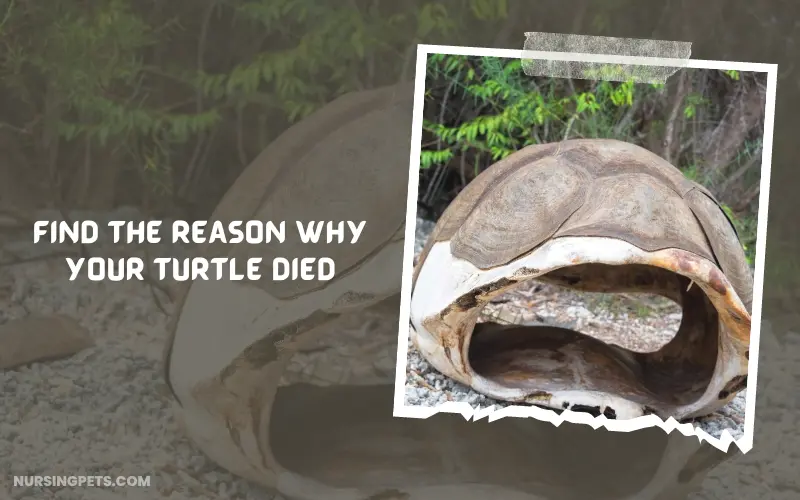
- Decide how you want to dispose of the turtle’s body. You can bury the turtle in a deep hole in your backyard or a pet cemetery, or you can cremate it through some pet services. But you should not place the turtle in any water system as it can harm other wildlife.
- Sanitize the Enclosure: If you plan to introduce another turtle in the same enclosure, thoroughly clean and disinfect the habitat to prevent the spread of any potential diseases.
- Monitor Surviving Turtles: Keep a close eye on any surviving turtles for signs of illness or distress.
- Grieve for your loss and remember the good times you had with your turtle. You can also talk to someone who understands your feelings or join a pet loss support group online or offline.
Frequently Asked Questions
1. Can Turtles Die from overheating?
Yes, overheating can kill a turtle. Overheating can damage their internal organs and cause heat stroke, which can be fatal. Some signs of overheating are lethargy, loss of appetite, foaming at the mouth, vomiting, and swelling.
So, if you have a turtle, you should provide it with a cool and shady area to escape the heat and monitor its temperature regularly.
2. Can Tension Cause Death in Turtles?
If you mean stress or anxiety, then yes, stress can cause death in turtles. Stress can weaken their immune system and make them more susceptible to diseases and infections. It can also affect their appetite, behavior, and metabolism.
Some sources of stress for turtles are poor water quality, overcrowding, predators, noise, and temperature changes1. You should try to minimize these factors and provide your turtle with a comfortable and safe environment.
3. Can Dehydration Cause Sudden Turtle Death?
Yes, dehydration can result in the unexpected demise of turtles. To regulate their body temperature and maintain health, turtles require access to fresh water. Dehydration can lead to organ failure, kidney stones, and shell problems in turtles.
Some signs of dehydration are closed or sunken eyes, loss of appetite, dry feces, and wrinkled skin. Therefore, you should always provide your turtle with fresh and clean water and mist its enclosure regularly to maintain humidity.
Final words
As you can understand now, the cause of the turtle’s unexpected death may come from several reasons. And without a proper examination, it is hard to tell what caused the incident. But we have provided almost all the usual reasons for this.
Try to identify the problem or cause and solve the issue. It will ensure a safe and healthy environment for the remaining turtles. However, if you can’t find out the reason, get help from a vet.
And if your turtle is already dead, remove it from the enclosure and give it a proper burial. Make sure you check on the signs of dying turtles, too, to prevent sudden death. You can help guarantee your turtle has a long, healthy, and happy life by being proactive about its care and being aware of the threats it may face.
References:
- https://seaworld.org/animals/all-about/sea-turtles/longevity/
- https://www.worldwildlife.org/stories/how-long-do-sea-turtles-live-and-other-sea-turtle-facts
- https://portal.ct.gov/DEEP/Wildlife/Fact-Sheets/Painted-Turtle
- https://www.nwf.org/Educational-Resources/Wildlife-Guide/Reptiles/Spiny-Softshell-Turtle
- https://www.britannica.com/animal/turtle-reptile/Longevity
- https://oceanblueproject.org/sea-turtle-facts/

